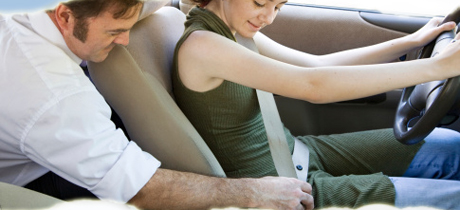
How Auto Manufacturers Are Promoting
Safe Driving for Teens
by Cameron Sloan
As a parent, you won’t always be in the car with your teenager to make sure he or she is buckling up, driving the speed limit and using turn signals. Fortunately, auto manufacturers are continually developing safe driving technology to help protect teen drivers behind the wheel. Here are some examples of features currently on the market:
- Parking assist helps teen drivers steer into parking spaces. This feature determines the proximity of other vehicles and uses a beep or dashboard light to notify the driver if there’s an obstacle. Some more advanced systems have a camera inside the car that allows drivers to see their blind spots. Parking assist is helpful for reverse and parallel parking, which can be especially challenging for new drivers.
Electronic stability control (ESC) helps teen drivers maintain control of their vehicles by applying the brakes if the car is at risk for going in the wrong direction to potentially avoid accidents. The system can anticipate whether a car is at risk of going in a direction the driver does not intend, which can happen when a vehicle understeers or oversteers.
-
Understeering: If a driver makes a sharp turn or swerves, the vehicle may continue traveling forward if the front wheels don’t have enough traction. This is known as understeering because the vehicle turns less than the driver wants.
-
Oversteering: If the back wheels don’t have enough traction, the rear end of the vehicle may start sliding, which can cause the car to spin. ESC helps prevent these situations by applying the brakes to individual wheels and/or reducing the vehicle’s speed.
Oversteering is one of the most common causes of rollovers. According to the National Highway Traffic Safety Administration (NHTSA), ESC could prevent 64 percent of car rollovers and 85 percent of SUV rollovers. Overall, the NHTSA estimates that ESC decreases single-car crashes by 26 percent and single-SUV crashes by 48 percent. Because of its significant impact on safe driving, the NHTSA is requiring that ESC come standard on all light-passenger vehicles by the 2012 model year.
-
Programmable key: Some car manufacturers offer programmable car keys that allow parents to customize what their teens can and can’t do behind the wheel, like limit the maximum speed and audio volume while their teens are driving. The keys, which come standard with some new cars, can activate a seatbelt alert that will not turn off until the driver buckles in. In some cases, the radio will stay muted until the driver puts on his or her safety belt.
These key systems can set the low fuel indicator to come on earlier than normal, prevent teen drivers from disabling other safety features like blind-spot monitoring, and alert drivers when they reach certain speeds. Limiting teens’ ability to speed not only helps them develop smart driving habits. It can also improve fuel economy, saving money.
In addition to protecting your teen with safe-driving technology, make sure you have car insurance your family can count on. Does your teen earn good grades in school? If so, he or she may be eligible for a good-student discount on car insurance for teenagers. |